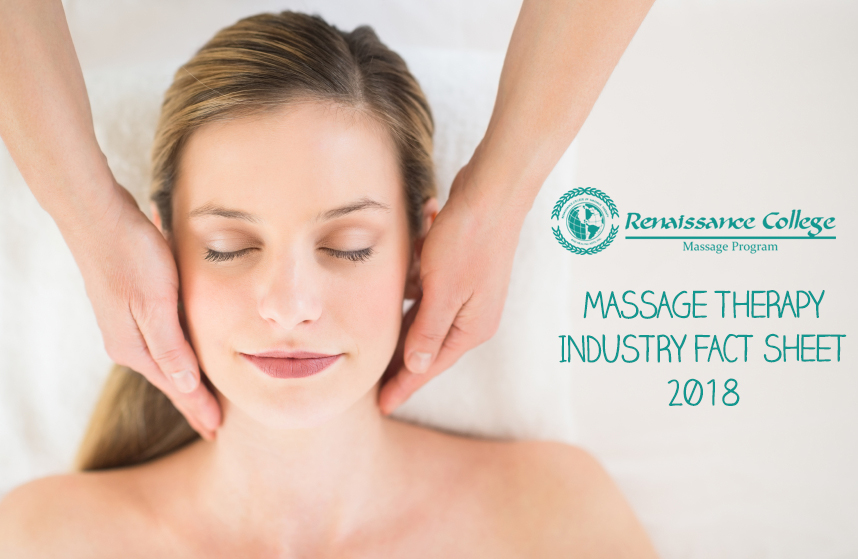Review a compilation of data gathered by the American Massage Therapy Association® (AMTA®) from U.S. government statistics, surveys of consumers and massage therapists and recent clinical studies on the efficacy of massage.
These data provide an overview of the current state of the massage therapy profession, public and medical acceptance of the value of massage and increasing consumer usage of massage therapy in the U.S.
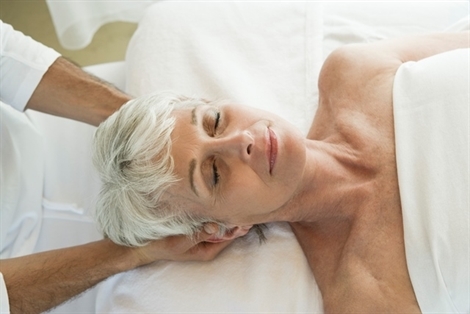
The Massage Therapy Profession
- Research estimates that massage therapy was a $16 billion industry in the country in 2017.2
- By comparison, in 2005, massage therapy was projected to be a $6 to $11 billion a year industry.1
- It is estimated that there are 335,000 to 385,000 massage therapists and massage school students in the United States.2
- From 2012 to 2017, revenue from alternative/complementary healthcare providers, which includes massage therapists, increased 4 percent, and employment increased 3.3 percent. Revenue growth is projected to continue at an average rate of 4 percent per year through 2022.3
- Between July 2016 and July 2017, surveys indicate that roughly 47.1 – 59.5 million adult Americans (19 – 24 percent) had a massage at least once.4,5
Who Is Today’s Massage Therapist?
Today’s massage therapists are…6
- Most likely to enter the massage therapy profession as a second career.
- Predominantly female (89 percent).
- At a median age of 46 years old. Twenty-two percent were younger than 35 in 2017.
- Most likely to be members of a professional organization.
- Most likely to be sole practitioners
- Working an average of 19.5 hours a week providing massage. (Excludes time spent on other business tasks such as billing insurance, bookkeeping, supplies, maintaining equipment, marketing, scheduling, etc.)
- Charging an average of $72.13 for one hour of massage vs. $71.64 in 2015.
- Earning an average wage of $58 an hour for all massage-related work.
- Heavily dependent on repeat clients.
- Likely to provide massage therapy in a number of settings, including client’s home/office, spa/salon, their own office, a health care setting, health club/athletic facility, or massage therapy only franchise or chain.
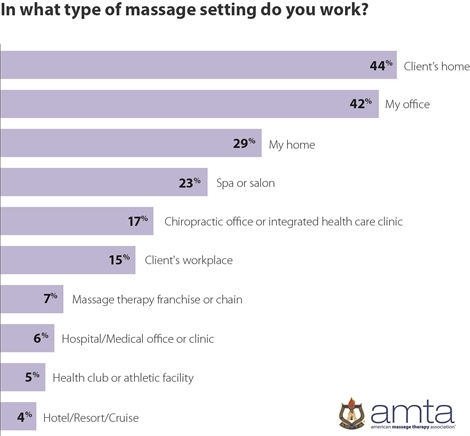
Massage Therapy as a Career
- In 2016, the average annual income for a massage therapist (including tips) was estimated to be $26,216.7
- While massage therapists work in a variety of work environments, sole practitioners account for the largest percentage of practicing therapists (72 percent). Of all therapists, 9 percent work at least part of their time at a client’s home/business/corporate setting, 42 percent at their office, 29 percent at their home, 23 percent in a health care setting, and 23 percent in a spa setting.4
- Eighty percent of massage therapists started practicing massage therapy as a second career.6
- Forty-two percent of massage therapists say they would like to work more hours of massage than they currently do.6
- Fifty percent of massage therapists also earn income working in another profession.6
- Of those massage therapists who earn income working in another profession, 12 percent practice other forms of bodywork, 8 percent work in other forms of health care, 8 percent teach/write/lecture about massage therapy, 7 percent work in personal care and 6 percent do movement therapy.6
Education and Credentials in the Massage Therapy Profession
- There are nearly 300 massage therapy schools and programs in the United States accredited by a national accrediting body.2
- Massage therapists have an average of 665 hours of initial training.6
- The vast majority of massage therapists (92 percent) have taken continuing education classes.7
- Massage therapists take an average of 21 hours of continuing education per year.6
State Regulation of the Massage Therapy Profession
- Currently, 46 states and the District of Columbia regulate massage therapists or provide voluntary state certification.
- In states that regulate massage therapy, massage therapists must meet the legal requirements to practice, which may include minimum hours of initial training and passing an exam.
- In states that do not regulate massage therapy, this task may fall to local municipalities.
- Most states that license massage therapists require a passing grade on the Massage & Bodywork Licensing Exam (MBLEx) or one of two exams provided by the National Certification Board for Therapeutic Massage & Bodywork.
- AMTA supports fair and consistent licensing of massage therapy in all states.
Who Gets Massage, Where and Why?
- According to AMTA’s 2017 Consumer Survey, an average of 19 percent of adult Americans received at least one massage between July 2016 and July 2017, and an average of 33 percent of adult Americans received a massage in the previous five years.7A Zogby Analytics survey of consumers in July 2017 indicated 24 percent received a massage from a massage therapist in the past year. 5
- In July 2017, 21 percent of women and 16 percent of men reported having a massage in the past twelve months.4
- Twenty-three percent of massage consumers reported receiving their last massage at a spa in 2017.4
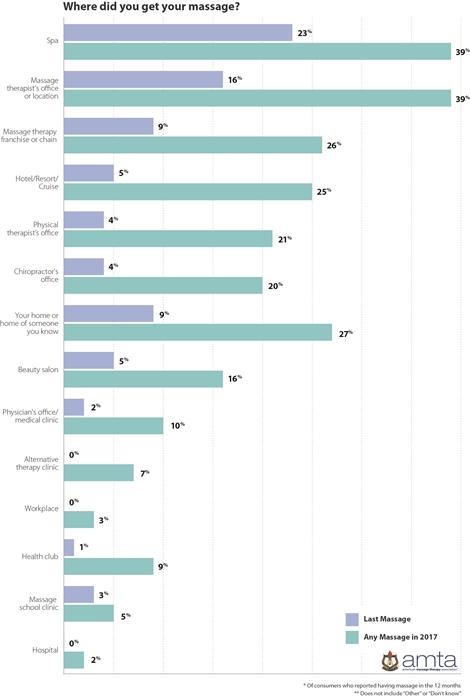
The primary reason people received massage was for health and wellness reasons.4
- Forty-three percent of adult Americans who had a massage between July 2016 and July 2017 received it for medical or health reasons such as pain management, soreness/stiffness/spasms, injury rehabilitation, or overall wellness, a slight decrease from 2016 data.
- Eighty-nine percent agree that massage can be effective in reducing pain.
- Twenty-nine percent of massage consumers had a massage for relaxation/stress reduction between July 2016 and July 2017.
Massage Therapy & Health Care
More Americans discussing massage with their doctors or health care providers.
- In July 2017, roughly fifty million American adults (18 percent) had discussed massage therapy with their doctors or health care providers in the previous year, consistent with past years’ data.4
- Of those 18 percent who discussed massage with their doctor or health care provider, 59 percent of their doctors or health care providers referred them to a therapist/strongly recommended massage therapy/encouraged them to get a massage. While physicians led the way in recommending massage (61 percent vs. 56 percent in 2016), chiropractors (40 percent) and physical therapists (46 percent) also recommended massage therapy when their patients discussed it with them.4
- Chiropractors continue to refer their patients to massage therapists, with 12 percent of respondents reporting receiving referrals at least once per week, and another 24 percent receiving referrals several times per month. Fifty-four percent of massage therapists received at least one referrral every 6 months or less from a hospital or medical office in 2017.6
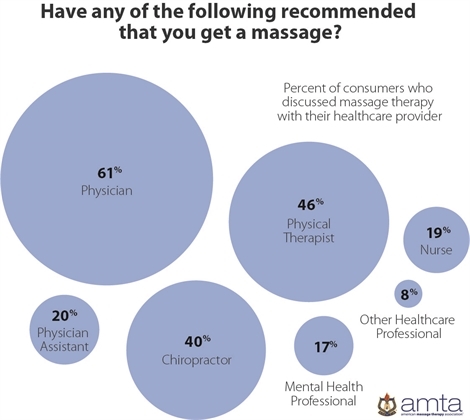
Massage therapists and consumers favor integration of massage into health care.
- Nearly two-thirds of adult Americans (64 percent) would like to see their insurance cover massage therapy.4
- The vast majority of massage therapists (97 percent) believe massage therapy should be considered part of the health care field.6
Massage Therapy Research
The therapeutic benefits of massage continue to be researched and studied. Recent research has shown the effectiveness of massage for the following conditions:
- Cancer-related fatigue8
- Low back pain9
- Osteoarthritis of the knee10
- Reducing post-operative pain11
- Boosting the body’s immune system functioning12
- Decreasing the symptoms of carpal tunnel syndrome13
- Lowering blood pressure14
- Reducing headache frequency15
- Easing alcohol withdrawal symptoms17
- Decreasing pain in cancer patients17
- Fibromyalgia18
About AMTA
The American Massage Therapy Association, the most trusted name in massage therapy, is the largest non-profit, professional association serving massage therapists, massage students and massage schools. The association is directed by volunteer leadership and fosters ongoing, direct member-involvement through its 51 chapters. AMTA works to advance the profession through ethics and standards, the promotion of fair and consistent licensing of massage therapists in all states, and public education on the benefits of massage.
References
1 Data compiled by American Massage Therapy Association 2017
2 IBIS World Industry Report OD6028 Massage Services, May 2017
3 IBIS World Industry Report 62139b Alternative Healthcare Providers in the US, June 2017
4 2017 AMTA Consumer Surveys
5 5 2017 Zogby Analytics survey
6 2017 AMTA Industry Survey
7 AMTA Consumer Surveys 2003-2016
8 Currin, J. Meister, E.A. (2008) A hospital-based intervention using massage to reduce distress among oncology patients. Cancer Nurs. 31(3):214-21. http://www.ncbi.nlm.nih.gov/pubmed/18453878?ordinalpos=3&itool=EntrezSystem2.PEntrez.Pubmed.Pubmed_ResultsPanel.Pubmed_DefaultReportPanel.Pubmed_RVDocSum
9 Preyde M. (2003) Effectiveness of massage therapy for subacute low back pain: a randomized controlled trial. Journal of Soft Tissue Manipulation, 8, 4 – 10.
10 Perlman AI, Sabina A, Williams AL, Njike VY, Katz DL. (2006) Massage Therapy for Osteoarthritis of the Knee. Arch Intern Med. 166(22):2533-8.
11 Piotrowski, M., Paterson, C., Mitchinson, A., Kim, H. M., Kirsh, M., Hinshaw, D. B. (2003) Massage as Adjuvant Therapy in the Management of Acute Postoperative Pain: A Preliminary Study in Men. Journal of the American College of Surgeons, 197(6), 1037-1046.
12 Rapaport, M. H., Schettler, P., Bresee, C. (2010) A Preliminary Study of the Effects of a Single Session of Swedish Massage on Hypothalamic-Pituitary-Adrenal and Immune Function in Normal Individuals. Journal of Alternative and Complementary Medicine, 16(10), 1-10.
13 Field, T., Diego, Miguel, Cullen, Christy, Hartshorn, Kristin, Gruskin, Alan, Hernandez-Reif, Maria, Sunshine, William. (2004). Carpal tunnel syndrome symptoms are lessened following massage. Journal of Bodywork and Movement Therapies. 8:9-14. http://www.massagetherapyfoundation.org/pdf/Massage%20and%20carpal%20tunnel%20syndrome.pdf
14 Hernandez-Reif M, Field T, Krasnegor J, Theakston H, Hossain Z, Burman I (2000). High blood pressure and associated symptoms were reduced by massage therapy. Journal of Bodywork and Movement Therapies, 4, 31 – 38.
15 Quinn C, Chandler C, Moraska A. Massage Therapy & Frequency of Chronic Tension Headaches. (2002) American Journal of Public Health. 92(10):1657-61
16 Reader M, Young R, Connor JP. (2005) Massage therapy improves the management of alcohol withdrawal syndrome. J Altern Complement Med. 11(2):311-3. PMID: 15865498.
17 American College of Physicians. (2008) Massage Therapy May Have Immediate Positive Effect On Pain And Mood For Advanced Cancer Patients. Science Daily 16 September. http://www.sciencedaily.com/releases/2008/09/080915174534.htm.
18 Castro-Sánchez, A.M., Matarán-Peñarrocha, G.A., Granero-Molina, J., Aguilera-Manrique, G., Quesada-Rubio, J.M., Moreno-Lorenzo, C. (2011). Benefits of massage-myofascial release therapy on pain, anxiety, quality of sleep, depression, and quality of life in patients with fibromyalgia. Evid Based Complement Alternat Med. 2011:561753.
Released February 23, 2017
© American Massage Therapy Association 2018. All rights reserved.
amtamassage.org® is a registered trademark of the American Massage Therapy Association
Released February 2018

